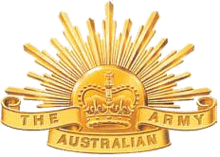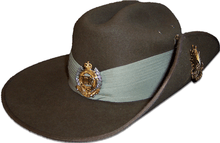Rising Sun (badge)

The Rising Sun badge, also known as the General Service Badge or the Australian Army Badge, is the official insignia of the Australian Army and is worn on the brim of a slouch hat or the front of a peaked cap (select appointments only). The badge is readily identified with the spirit of ANZAC, the legend of the Australian soldier (or digger), and the esprit de corps of the Army itself, due to its association with the landings at Gallipoli in 1915.[1] Today, new recruits receive the iconic badge with their initial issue of equipment, which happens within their first three days of enlistment.
History
Origins
The origins of the rising sun badge are disputed. It has been suggested that the association of the badge with the rising sun came from the trademark of a popular brand of jam at the time of its inception, known as 'Rising Sun jam', while other scholars have suggested that it represented the rising sun from the start. Rising sun designs had appeared on early Australian colonial coins and military insignia decades before the federation of the Australian colonies in 1901, and may have represented the image of Australia as 'a young nation' and a 'new Britannia'.[2]
As early as the 1820s, the symbol of a 'rising sun' was used by various progressive organisations, loosely characterised under the banner "Advance Australia". The rising sun crest used in the New South Wales colonial and State crests was taken from the crest used on the first Advance Australia Arms, circa 1821, and consistently since then.[3] The oldest known example is the 'Advance Australia' coat of arms. The 'Advance Australia Arms' (named because of the motto inscription) became widely used in New South Wales and the neighbouring colonies by private corporations and individuals. Although they never had any official status, they formed the basis for several official coats of arms, including the New South Wales coat of arms. The representation below was reputedly painted for Thomas Silk, the son of the captain of the Prince of Orange, a convict ship that visited Sydney in 1821. The symbol struck a chord with the pre-federation population and many examples still exist on colonial architecture.[4]
Military use

In 1902 a badge was urgently sought for the Australian contingents raised after Federation for service in South Africa during the Second Boer War. The most widely accepted version of the origin of the badge is that which attributes the selection of its design to a British officer, Major General Sir Edward Hutton, the newly appointed General Officer Commanding, Australian Military Forces. The design was subsequently first worn by the Australian Commonwealth Horse.[5] Hutton had earlier received a "Trophy of Arms" as a gift from Major Joseph Gordon, a long standing military acquaintance, comprising mounted cut and thrust swords and triangular Martini Henri bayonets arranged in a semicircle around a brass crown.[2] To Hutton the shield was symbolic of the co-ordination of the Naval and Military Forces of the Commonwealth.[6] Three different designs were created, and they formed the basis of a new design created in 1903, which was subsequently adopted as the General Service Badge in 1911. The original badge bore the words 'Australian Commonwealth Military Forces' on the scroll at the bottom of the badge.[2] However, as the original design was created in haste it was subsequently redesigned, and was later worn by soldiers of the First Australian Imperial Force in World War I and the Second Australian Imperial Force (2nd AIF) in World War II, being used on both the slouch hat and the tunic, while it was also used in some Regimental badges.[2]
Since its inception the basic form of the 1904 version has remained unchanged although modifications have been made to the wording on the scroll and to the style of crown.[7] Notably, although no badge was ever struck with the wording 'Australian Imperial Force', this wording has been used as a headstone design. In 1945, the Department of the Army recommended that two separate badges for Army war graves of World War II be used to distinguish between members of the 2nd AIF and the Citizen Military Force (CMF). Subsequently this variation appeared only on the headstone badges of deceased 2nd AIF members.[8]
Design changes
In 1949, when Corps and Regimental badges were reintroduced, the badge was changed again. The wording on the scroll was changed to read 'Australian Military Forces', deleting the word 'Commonwealth'.[2] Nevertheless the earlier badge remained in common use with recruit training units until at least the late 1960s.[8]
Following the ascent of Her Majesty Queen Elizabeth II to the throne, the Crown on the badge was consequently changed from a King's (Tudor) Crown to a Queen's (St. Edward's) Crown on the 1956 version.[7]
In 1969 the badge was again modified to incorporate the Federation Star and Torse Wreath from the original 1902 version of the badge, while in 1972 the scroll wording was shortened again to 'Australia'.[2] However, due to the number of older badges still held in stock this badge was not produced for issue until the late 1980s.[8]
In 1991 a new design was produced which returned the design to one similar to that of the original World War I badge, to coincide with the commemoration of the 75th anniversary of the fighting at Gallipoli.[9] The inscription on the scroll was again changed and now reads: 'The Australian Army'.[2]
In 1995 the badge was altered for the last time when the metal was changed from 1160 aluminium, returning it to brass for the first time since World War II, but with a copper and gold plate, while also raising the crown and arms and re-introducing piercings as it had in 1914, and thus returning to its traditional layout. The version used today is the seventh iteration of the design used as the General Service Badge.[7]
Development of the design
-

Original concept by Major Gordon
-

The first pattern of February 1902
-

The third pattern used from 1904–1949
-

The fifth pattern used from 1954–1969
-

The sixth pattern used from 1969–1991
-

The seventh pattern used from 1991
Notes
- ↑ Galligan and Winsome 2004, p. 132.
- ↑ 2.0 2.1 2.2 2.3 2.4 2.5 2.6 Dennis et al 2008, p. 452.
- ↑ "Centenary of NSW Coat of Arms: Origins: Seals, Badges, and Unofficial Arms". Heritage Council of New South Wales. Retrieved 9 May 2010.
- ↑ "The earliest Advance Australia Arms, presented to Captain Silk c.1821". Heritage Council of New South Wales. Retrieved 9 May 2010.
- ↑ Dennis et al 2008, p. 59.
- ↑ Jobson, C. (1998). "The Rising Sun Badge". ANZAC Day Commemoration Committee (Qld) Incorporated. Retrieved 9 May 2010.
- ↑ 7.0 7.1 7.2 "The Rising Sun: Australia's most famous badge.". Digger History. Retrieved 9 May 2010.
- ↑ 8.0 8.1 8.2 Aitken, Peter (2010). "The General service badge". Australian War Memorial. Retrieved 9 May 2010.
- ↑ "History of the Rising Sun Badge". Department of Defence. Retrieved 9 May 2010.
References
- Dennis, Peter; Grey, Jeffrey; Morris, Ewan; Prior, Robin; and Jean Bou (2008). The Oxford Companion to Australian Military History (Second ed.). Melbourne, Victoria: Oxford University Press. ISBN 978-0-19-551784-2.
- Galligan, Brian; Roberts Winsome (2004). Australian Citizenship. Carlton, Victoria: Melbourne University Publishing. ISBN 0-522-85094-4.